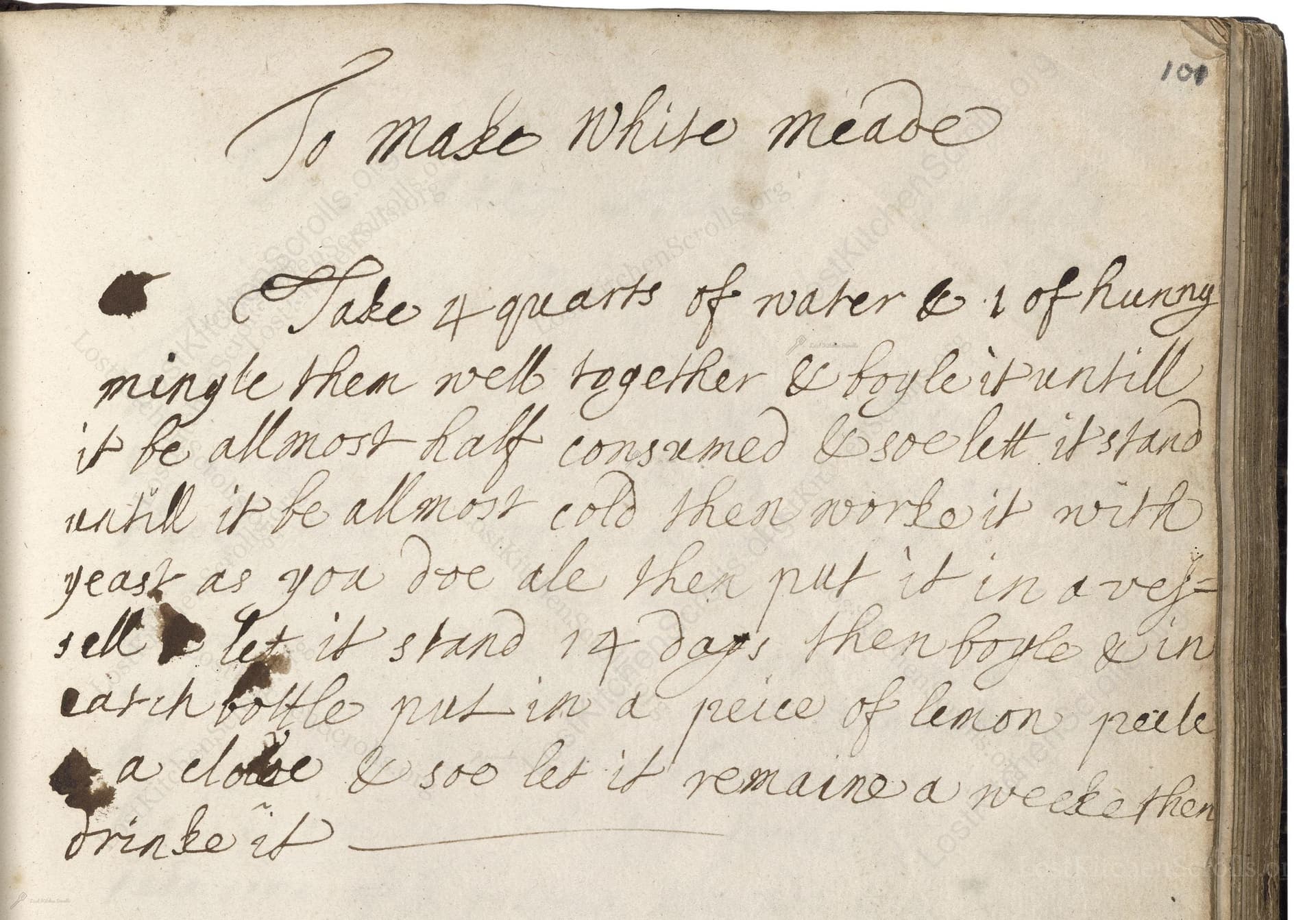To Make White Meade
From the treasured pages of Cookbook of Susanna Packe
Written by Susanna Packe

To Make White Meade
"Take 4 quarts of water & 1 of hunny mingle them well together & boyle it untill it be allmost half consumed & soe lett it stand untill it be allmost cold then worke it with yeast as you doe ale then put it in a vessell & lett it stand 14 days then bottle it in each bottle put in a peice of lemon peele & a clove & soe let it remaine a weeke then drinke it"
Note on the Original Text
The original recipe is written as a single, dense, run-on sentence—typical of 17th-century manuscript cookery. Spellings such as 'hunny' for 'honey', 'boyle' for 'boil', and 'lett' for 'let' reflect the phonetic and unstandardized nature of early modern English spelling. The recipe assumes foundational kitchen knowledge, omitting precise measures and temperatures. 'Worke it with yeast' and references to making ale place the recipe in a home-brewing tradition, where instructions were oral and hands-on, rather than exact.

Title
Cookbook of Susanna Packe (1674)
You can also click the book image above to peruse the original tome
Writer
Susanna Packe
Era
1674
Publisher
Unknown
Background
A delightful culinary treasure from the 17th century, this book offers a charming glimpse into the flavors and techniques that graced English kitchens in Susanna Packe's time, promising a feast of history and taste for any food enthusiast.
Kindly made available by
Folger Shakespeare Library
This recipe hails from the manuscript collection of Susanna Packe, dated 1674. In the 17th century, mead was a popular homemade beverage, enjoyed for both its flavor and mild alcoholic content. Packe's record reflects the domestic skills and culinary curiosities of English gentlewomen, who would’ve prepared such drinks in country households. The addition of lemon peel and clove at bottling reveals the era's increasing appetite for imported spices and fresh citrus, signaling status and taste.

In 1674, the process would have involved a large cauldron or iron pot suspended over an open hearth fire to boil the honey and water. A long wooden paddle or spoon was used for stirring. After boiling, the mixture would ferment in a wooden barrel, stoneware crock, or a glass carboy covered with cloth. Bottling was done in heavy glass bottles, sealed with corks. Citrus fruits and spices would be prepared by hand, with simple knives and paring tools.
Prep Time
10 mins
Cook Time
1 hr
Servings
10
We've done our best to adapt this historical recipe for modern kitchens, but some details may still need refinement. We warmly welcome feedback from fellow cooks and culinary historians — your insights support the entire community!
Ingredients
- 1 gallon plus 3 cups water
- 1 quart plus 1 cup honey (substitute: mild-flavored wildflower or clover honey if original varieties unavailable)
- active dry yeast (or brewing yeast, quantity per package instructions)
- fresh lemon peel (1 small piece per bottle)
- whole cloves (1 per bottle)
Instructions
- To recreate Susanna Packe's 1674 'White Meade' in a modern kitchen, combine 1 gallon plus 3 cups of water with 1 quart plus 1 cup of good quality honey.
- Stir them thoroughly, then bring the mixture to a boil and cook uncovered until roughly half the volume has evaporated (you'll have about 2 2/3 quarts remaining).
- Remove from the heat and let it cool until just warm—around body temperature (86-95°F).
- Add a small amount of active baking yeast (or traditional brewing yeast, if available), mixing well as you would for brewing ale.
- Transfer the liquid into a sanitized fermentation vessel and let it ferment in a cool space for 14 days.
- After this period, carefully bottle the mead: in each bottle, add a small strip of lemon peel and a whole clove for aromatic complexity.
- Cork or cap tightly, and let the bottles rest for another week before enjoying your homemade early-modern mead.
Estimated Calories
230 per serving
Cooking Estimates
You will spend most time waiting for the liquid to reduce by half on the stovetop (about 1 hour) and letting the mead cool before adding yeast (about 30 minutes). Prep is just mixing the honey and water, which only takes about 10 minutes.
As noted above, we have made our best effort to translate and adapt this historical recipe for modern kitchens, taking into account ingredients nowadays, cooking techniques, measurements, and so on. However, historical recipes often contain assumptions that require interpretation.
We'd love for anyone to help improve these adaptations. Community contributions are highly welcome. If you have suggestions, corrections, or cooking tips based on your experience with this recipe, please share them below.
Join the Discussion
Rate This Recipe
Dietary Preference
Main Ingredients
Culinary Technique

Den Bockfisch In Einer Fleisch Suppen Zu Kochen
This recipe hails from a German manuscript cookbook compiled in 1696, a time whe...

Die Grieß Nudlen Zumachen
This recipe comes from a rather mysterious manuscript cookbook, penned anonymous...

Ein Boudain
This recipe comes from an anonymous German-language manuscript cookbook from 169...

Ein Gesaltzen Citroni
This recipe, dating from 1696, comes from an extensive anonymous German cookbook...
Browse our complete collection of time-honored recipes



